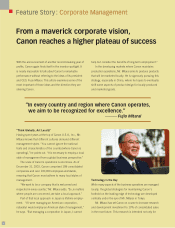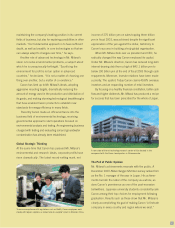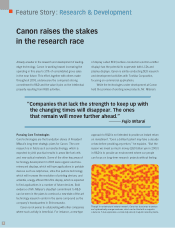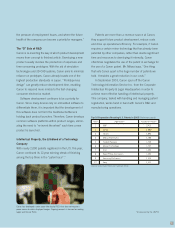Canon 2003 Annual Report Download - page 18
Download and view the complete annual report
Please find page 18 of the 2003 Canon annual report below. You can navigate through the pages in the report by either clicking on the pages listed below, or by using the keyword search tool below to find specific information within the annual report.
Office Imaging Products
Product Group Report
Ikuo Soma
Chief Executive
Office Imaging Products Operations
The introduction of
new digital
technologies and
value-added solutions
helped Office Imaging
Products to steer
successfully through
fast-moving markets.
Despite the fact that the office equipment market is almost
saturated in developed countries, we saw our largest sales
figures ever in 2003. China accounted for much of the
extra sales, but it’s important to realize that added value,
in the form of networking, integration, color copying, and
high-speed models, comprises a significant portion of our
sales. Incidentally, only 5% of our copying machine sales
is now analog—the remaining 95% is digital.
It’s a fair assumption that the market will polarize into
high-end and low-end models. In the high-end market,
we’re providing total hardware/software solutions. We’re
now using a sales strategy in Japan that we call D
2
(Digital,
Devices) whereby Canon Sales Co., Inc. and Canon Inc.
link forces to provide solutions, not just copying machines,
to our end-user customers. A similar strategy is already in
place in the U.S.A. For Europe we hope to implement it in
the coming year.
Among the products and services marketed by the D
2
team is our proprietary Java-based Multifunctional Embed-
ded Application Platform (MEAP), which enables our clients
to customize their multifunction devices (MFDs) according to
their needs. Of course, the sales process here is long-term,
up to years in length, but our bigger clients appreciate the
flexible solutions we provide. Right now, customized solutions
are providing about 4% of our [domestic] sales, but we
hope to get this figure up to 19% by the end of 2006.
As it happens, 50% of our R&D staff and budget is on
the software development side. I think that gives you a pretty
good idea of our future priorities.
With regard to production, we’re making the mid-range
products in China, and the high-end models in Japan. We
are considering using our European and American facilities
mainly for kitting out the base models, which would then
be localized for different markets. The European centers
will also be involved in the recycling of cartridges, etc.
Europe’s a lot more active than the U.S.A. in this regard.
Looking ahead, we see digital technology continuing to
reshape the reproduction market. Currently divided into four
segments—offset, electrophotography [copying machines],
inkjet and silver-halide photographic processes—the
market will consolidate into two areas as silver-halide and
offset continue to decline. Office Imaging Products Opera-
tions will focus, as we have for some time, on filling the gap
with innovations in electrophotography and inkjet printing.
(
From an interview with Mr. Soma on January 19, 2004
)
16
























